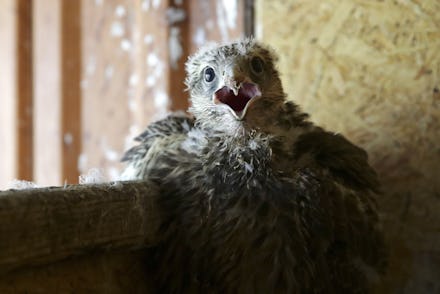Heat waves are killing baby birds by forcing them to flee their nests before they can fly

In the early 1900s, coal miners would bring canaries with them into the mines to serve as warning signals: If the tiny birds perished, it was an indicator that toxic gases like carbon monoxide were leaking in the tunnels. A century later, we have a new bird-based harbinger of danger. According to a report from The Washington Post, birds of prey in the Pacific Northwest are fleeing their nests before they are fully capable of flying, all in an effort to escape that devastating heat that has been pounding the region for weeks.
As record-breaking temperatures continue to plague Oregon, Washington, California, and other states out west, wildlife is struggling to find ways to escape the heat. Birds of prey often set up nests in tree tops, often in areas with direct sunlight and minimal shade. This normally isn't an issue — temperatures during June and July stay manageable enough for most birds, and by the time the year's hottest weather arrives in August, the babies are mature enough to fly and find shade. But as the heat waves have rolled in, the direct sunlight has simply become too much for these babies to take. In order to survive, they seek shelter and shade outside of the nest — but are too young to fly and thus sometimes fall helplessly to the ground.
The result is distressing. These birds suffer injuries like head trauma, fractured wings, and broken bones if they fall from too high up. People keep finding these poor babies in rough shape, and wildlife centers have been inundated with birds in need of care and rehabilitation. According to the Post, a wildlife organization in Oregon reported receiving as many injured birds over a three-day period as they would typically get for an entire season. The Orphaned Wildlife Rehabilitation Society in Delta, British Columbia, reported receiving between 12-20 birds in need of care each day, which it called "record-breaking admissions for wildlife intakes." The Audubon Society of Portland said it took in more than 100 Cooper's hawks over a four-day period. The Blue Mountain Wildlife organization said it has taken in 118 birds at its Oregon location, and another 70 at its site in Washington.
Many of these baby birds do end up in good hands, albeit under terrible conditions. Wildlife groups have managed to nurse some of them back to health, and some have already reported being able to reunite the found hawks with their families. Others have not been so lucky, though: Some groups have received birds that sustained injuries so severe that they had to be euthanized.
Birds are among the creatures hardest hit by these extreme weather events, which continue to happen as a result of human-caused climate change. Last year, there were reports of widespread death among migratory birds in the fall. The reason: They were forced away from their normal path by wildfires and were pushed to take routes with less reliable food sources. As a result, thousands of birds died of starvation. These are unfortunate indicators of the state that our planet is in, and we shouldn't ignore them. Like the canaries in the coal mines, if the birds are dying, it means something is very, very wrong.